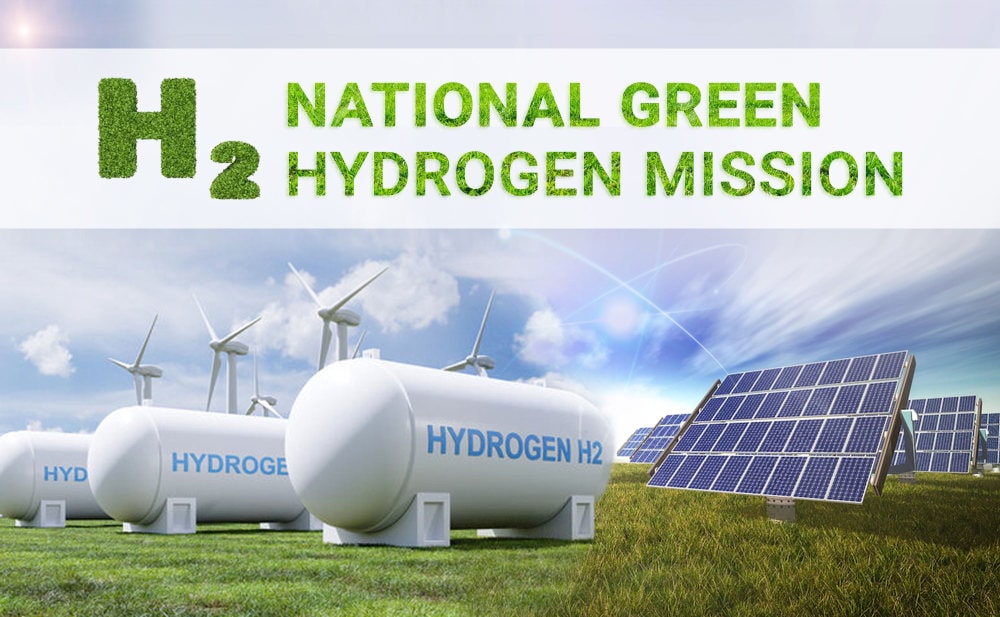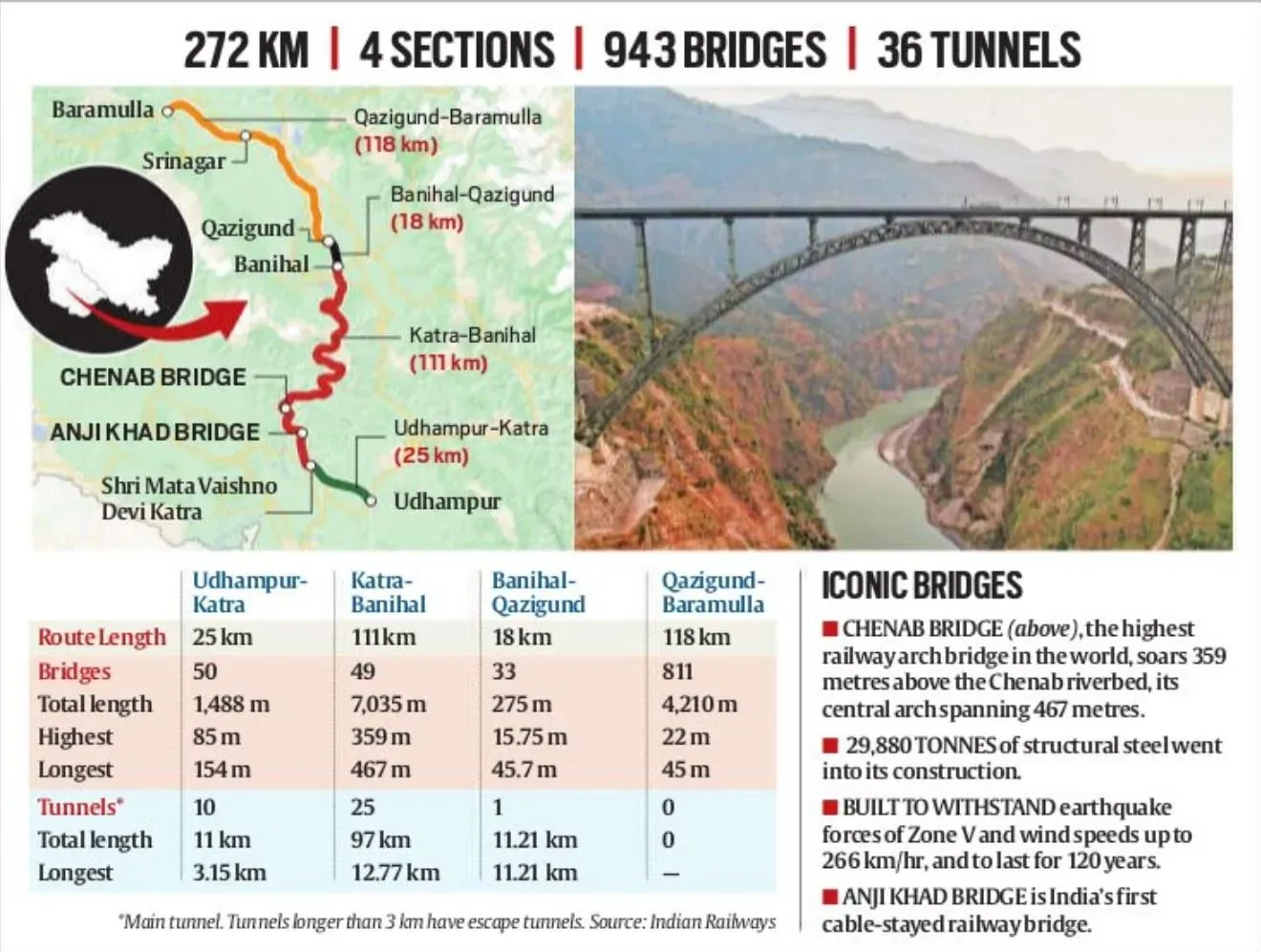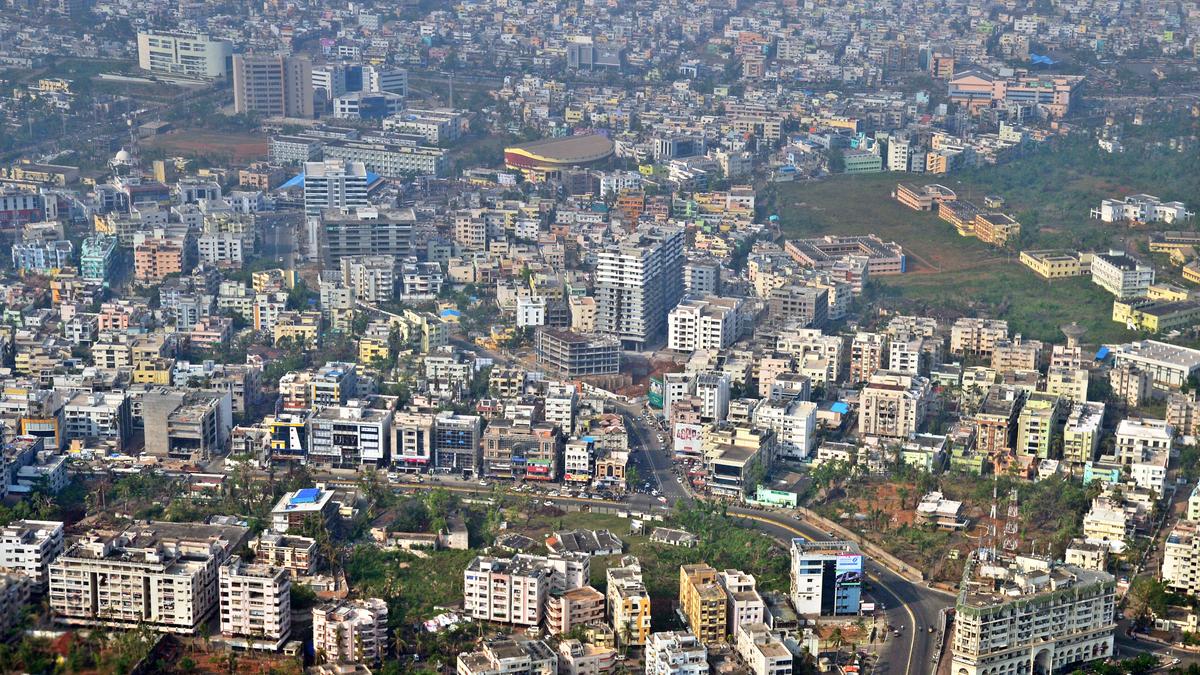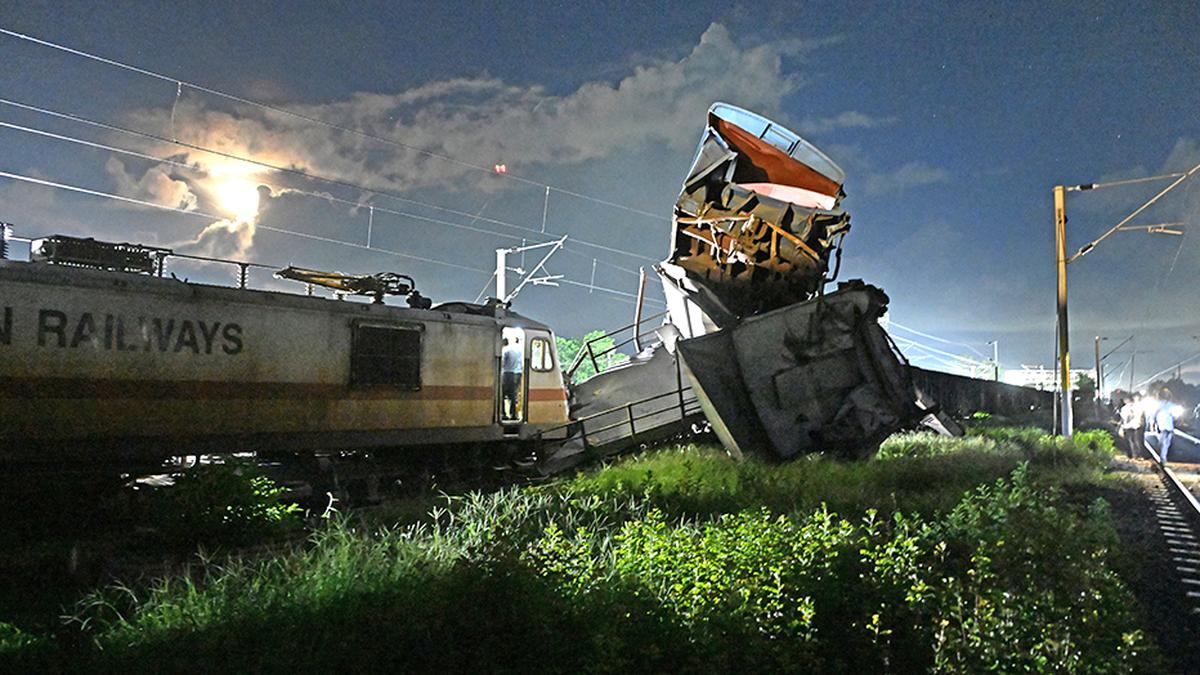National Green Hydrogen Mission

- 22 Jun 2025
In News:
India’s green hydrogen sector stands at a critical crossroads. Once buoyed by global enthusiasm for clean fuels, it now faces export-related headwinds due to geopolitical uncertainties and wavering international policy commitments. In response, India has strategically pivoted toward building a robust domestic ecosystem to ensure long-term energy security and decarbonisation.
National Green Hydrogen Mission
Launched in 2023, the National Green Hydrogen Mission aims to establish India as a global green hydrogen hub. With an outlay of ?19,744 crore, the mission targets the production of 5 million metric tonnes (MMT) of green hydrogen by 2030, along with domestic manufacturing of electrolysers under the SIGHT (Strategic Interventions for Green Hydrogen Transition) programme.
To ensure credibility and transparency, the Ministry of New and Renewable Energy (MNRE) introduced a measurement and certification framework in April 2025 to verify green hydrogen at the production stage. These foundational steps are essential for market integrity, both domestically and internationally.
Export Slowdown: Policy and Geopolitical Challenges
India’s early ambitions to become a major green hydrogen exporter have been hampered by global developments. Projects like ReNew’s green ammonia facility in Odisha face uncertain prospects due to declining international demand. Contributing factors include policy uncertainty in key markets like the United States, where a potential rollback of the Inflation Reduction Act (via the “Big Beautiful Bill”) threatens long-term clean energy investments.
Moreover, European procurement initiatives, such as Germany’s Hintco under the H2Global Foundation, have seen low industry response, reflecting weak investor confidence. In response, India has initiated talks with European ports like Rotterdam and Antwerp, and is pushing for FTA provisions to lower import duties on green hydrogen, aiming to keep future export channels open.
Domestic Market Creation:
Faced with uncertain exports, India is actively cultivating domestic demand. A recent tender for 8 lakh tonnes of green hydrogen received full bids, indicating growing interest from Indian firms. The Solar Energy Corporation of India (SECI) is managing another tender for 7 lakh tonnes, primarily for the fertiliser sector.
Pilot initiatives are also being deployed in sectors such as steel, shipping, and transportation. For example, hydrogen fuel cell buses are being tested in five cities, including Ladakh. Industry experts advocate for mandatory blending in sectors like fertilisers to accelerate adoption.
Cost Competitiveness: The Core Challenge
At present, green hydrogen costs $4–$5 per kg, significantly higher than $2.3–$2.5 per kg for grey hydrogen. A report by CII, Bain & Co., and RMI attributes this to immature supply chains, high capital costs, and limited scale. The report recommends pragmatic interventions such as:
- Blending green hydrogen into existing grey hydrogen or natural gas systems.
- Promoting uptake in niche sectors like ceramics and chemicals.
- Public procurement of green steel to create economies of scale.
Conclusion:
While India’s long-term vision to lead the green hydrogen transition remains intact, current challenges necessitate a strategic rebalancing. Prioritising domestic demand creation, infrastructure development, and cost reduction over near-term exports will be key. If implemented effectively, India may replicate its renewable energy success, positioning itself as a global leader in green hydrogen by the next decade.
Kashmir Rail Link: A Strategic and Developmental Milestone

- 07 Jun 2025
In News:
The launch of the Vande Bharat Express between Katra and Srinagar by Prime Minister Narendra Modi marks a transformative chapter in Jammu and Kashmir’s infrastructural journey. The long-awaited completion of the Udhampur-Srinagar-Baramulla Rail Link (USBRL) is not merely a technological feat, but a symbol of national integration, economic upliftment, and inclusive development in the Kashmir Valley.
Historical Background
The evolution of rail connectivity in Jammu and Kashmir dates back to the colonial era when, in 1897, a 40–45 km rail line linked Jammu to Sialkot (now in Pakistan). Subsequent plans to extend railways to Srinagar in the early 20th century were shelved. After the 1947 Partition, Jammu was cut off from the rail grid as Sialkot became part of Pakistan. The region had to wait until 1975 for the inauguration of the Pathankot–Jammu line. The Jammu–Udhampur line, started in 1983, was completed only in 2004.
In 1994, the rail project was further extended to include Srinagar and Baramulla, and the USBRL was declared a national project in 2002, with the initial estimated cost of ?2,500 crore.
USBRL: Engineering Triumph
The fully operational 272 km USBRL has been completed at a revised cost of ?43,780 crore. It includes 36 tunnels, 943 bridges, and several record-setting engineering marvels in the seismically active, snow-covered terrain of the Shivalik and Pir Panjal ranges.
- Chenab Bridge: The world’s tallest railway arch bridge, 359 meters above the riverbed, surpassing even the Eiffel Tower. Designed to withstand wind speeds of 260 km/h and extreme temperatures, it spans 1,315 meters and has a life expectancy of 120 years.
- Anji Khad Bridge: India’s first cable-stayed rail bridge, located in Reasi, towers 331 meters above the river and stretches 725 meters. Its iconic inverted Y-shaped pylon is supported by 96 high-tensile cables.
- Tunnel T-49: At 12.77 km, it is India’s longest transport tunnel, located in Ramban district, designed to ensure seamless all-weather connectivity.
Strategic and Socio-Economic Significance
This rail link is a game-changer for the region. By reducing Katra–Srinagar travel time to just 3 hours, it ensures year-round, all-weather accessibility, even during harsh Himalayan winters. The connectivity is critical not only for civilians but also for the rapid movement of security personnel in this strategically sensitive region.
Economically, the rail link is poised to boost trade and tourism. It will facilitate the quicker and more cost-effective transport of local produce such as apples, walnuts, saffron, pashmina, and handicrafts, thereby integrating the Valley with national markets. Reduced logistics costs will also lower the prices of essential goods imported into Kashmir.
Way Forward
The upcoming extension to Jammu Tawi aims to further enhance nationwide connectivity to Srinagar. This project stands as a testament to India’s commitment to inclusive development, national unity, and strategic infrastructure in border regions. With its blend of engineering excellence and socio-political impact, the USBRL reinforces the vision of a Viksit Bharat that leaves no region behind.
Urban Flooding in India: A Growing Challenge and the Path to Resilience
- 02 Jun 2025
In News:
Urban flooding has emerged as a critical challenge in India’s rapidly urbanising landscape. Cities like Delhi, Mumbai, Bengaluru, and Chennai face recurrent inundations, leading to loss of life, infrastructure damage, and economic disruptions. This crisis stems from a combination of outdated urban drainage systems, rapid concretisation, encroachment on natural water bodies, and climate change-induced extreme weather events.
The Urban Drainage Crisis
Urban drainage refers to the infrastructure that manages rainwater and prevents flooding. However, over 70% of India’s urban areas lack scientifically designed stormwater systems (MoHUA, 2019). Mumbai’s stormwater drains, originally built in the 1860s, can handle only 25 mm of rainfall per hour, while rainfall events often exceed 100 mm/hour. Delhi's drainage is based on 1976 norms, incapable of handling current rainfall intensities, such as the 185.9 mm received in a single day in May 2025. Bengaluru’s network is outdated, with over 65% of its lakes encroached and connected stormwater drains severely undersized.
Key causes of urban flooding include:
- Natural Factors: Intensifying short-duration rainfalls due to climate change, low-lying topographies.
- Man-made Factors: Unplanned urbanisation, loss of wetlands, illegal constructions, outdated design standards, infiltration of sewage into stormwater lines, and poor maintenance.
Economic and Environmental Impacts
Floods cause the highest economic damage among natural disasters in India. In 2024, Mumbai received 300 mm of rain in six hours, crippling the city’s transport and health systems. Chennai’s monsoon floods in 2024 led to massive waterlogging due to blocked drains and concretised surfaces.
Urbanisation has drastically increased impervious surfaces, reducing natural infiltration and increasing runoff. Nashik, for instance, witnessed rapid impervious expansion, contributing significantly to urban flooding.
Technological Solutions: GIS and Remote Sensing
To tackle urban flooding, advanced tools like Geographic Information Systems (GIS) and remote sensing are being deployed:
- Satellite Monitoring: ISRO and NRSC use high-resolution imagery to monitor rainfall, land use, and flood-prone zones. LiDAR-generated Digital Elevation Models (DEMs) help map vulnerable areas.
- Hydrological Modelling: Tools like HEC-HMS and HEC-RAS simulate flood scenarios and help plan mitigation strategies.
- Urban Drainage Mapping: GIS assists in identifying drainage bottlenecks and encroachments. For instance, GIS studies in Ahmedabad and West Bengal’s Keleghai Basin have enabled flood risk zoning.
Government Interventions
Several policies and programs support flood mitigation:
- AMRUT 2.0 and Smart Cities Mission: Promote integrated stormwater systems and sustainable urban drainage.
- Model Building Bye Laws (2016): Mandate rainwater harvesting.
- Jal Shakti Abhiyan, Atal Bhujal Yojana, and Amrit Sarovar Mission: Encourage water body rejuvenation and groundwater recharge.
- NDMA Guidelines: Recommend real-time flood forecasting and risk mitigation using satellite data.
Future Directions
Moving forward, flood resilience must be built through:
- Green Infrastructure: Restoring wetlands, using bioswales and permeable pavements.
- Smart Drainage Systems: IoT-enabled sensors for real-time monitoring and early warnings.
- AI Integration: Enhancing prediction models using real-time meteorological data.
- Policy Enforcement: Preventing illegal constructions on floodplains and drainage channels.
- Community Engagement: Raising awareness on waste disposal and flood preparedness.
Conclusion
Urban flooding in India reflects the failure to integrate environmental planning into urbanisation. However, with the aid of emerging technologies, inter-agency coordination, and proactive governance, Indian cities can transform from reactive flood responses to resilient urban systems. A holistic approach combining infrastructure, nature-based solutions, and data-driven policies is essential for sustainable urban development.
Road Safety in India
- 16 May 2025
Context:
India is at a critical juncture in its mobility transformation. With over 6.3 million km of road network, the second-largest globally, the nation faces a paradox: rapid urbanisation and vehicle growth have brought both economic momentum and a rising toll of road fatalities. In 2022, India recorded 1.68 lakh road deaths, translating to 12.2 deaths per 1 lakh population—substantially higher than countries like Japan (2.5) and the UK (2.6). These crashes cost India 3% of its GDP annually, eroding human capital and stalling development.
Road Safety as a Fundamental Right
The right to safe mobility stems from Article 21 of the Constitution, which guarantees the right to life. This makes road safety not merely a technical issue but a public good and a human right. With India’s urban population expected to reach 50% by 2047, ensuring the safety of all road users—particularly pedestrians, cyclists, elderly, and children—is essential for inclusive development.
Key Challenges in India’s Road Safety Landscape
- Human Error: About 78% of crashes are due to driver fault—overspeeding, drunk driving, and poor lane discipline.
- Infrastructure Gaps: Over 5,000 black spots, inadequate pedestrian zones, and unscientific road designs persist across urban and rural areas.
- Weak Enforcement: Despite the Motor Vehicles (Amendment) Act, 2019, enforcement is inconsistent, and deterrence is weak.
- Emergency Care Deficits: Rural areas suffer from delayed trauma response, poor ambulance coverage, and lack of cashless care.
- Fragmented Governance: Overlapping responsibilities between Centre and States lead to diluted accountability and suboptimal implementation.
Government Response: The Four Es Framework
- Engineering: Mandatory safety audits, black spot rectification, e-DAR digital accident recording, and vehicle safety mandates (airbags, ABS, Bharat NCAP ratings).
- Enforcement: e-Challans, CCTV-based monitoring, automated vehicle fitness testing, and stricter penalties under the MV Act.
- Education: Road Safety Advocacy Scheme, National Road Safety Month, driver training centres in every district.
- Emergency Care: Good Samaritan protections, ambulances with paramedics at toll plazas, and pilot cashless treatment schemes.
Strategic Roadmap:
- Safe System Approach: Design roads that are forgiving of human error—wider footpaths, dedicated cycling lanes, pedestrian islands, and speed calming measures.
- National Road Safety Authority: A unified central body to integrate policy, funding, and enforcement between Centre and States.
- Innovative Financing: Mandate auto manufacturers to channel CSR funds into road safety initiatives for 20–25 years, supporting infrastructure, trauma care, and R&D.
- Data-Driven Policies: Strengthen digital accident databases to enable evidence-based decision-making and real-time response.
- Capital Investment: Adopt the World Bank’s recommendation of $109 billion investment over a decade to halve road deaths by 2030.
Conclusion
Road safety is not an adjunct concern—it is integral to India’s Vision of Viksit Bharat 2047. Reducing road fatalities is essential for economic productivity, public health, and constitutional morality. A coordinated, inclusive, and adequately financed national strategy can transform India’s roads from death traps into pathways of safe, equitable mobility.
India’s Urban Infrastructure

- 28 Nov 2024
Introduction
India’s urban population is projected to double from 400 million to 800 million by 2050. This demographic shift presents both challenges and opportunities for transforming the country’s urban infrastructure. To meet the growing needs of urban areas, India will require an investment of approximately ?70 lakh crore by 2036, a figure significantly higher than current spending levels.
Financial Challenges in Urban Infrastructure
- Investment Gap
- The current annual investment in urban infrastructure stands at ?1.3 lakh crore, which is only 28% of the ?4.6 lakh crore needed annually.
- A large portion of the existing investment, around 50%, is directed towards basic urban services, with the remainder allocated to urban transport.
- Municipal Finances
- Municipal finances have remained stagnant at 1% of GDP since 2002.
- Despite increased transfers from the central and state governments, municipal bodies face financial strain.
- The contribution of municipal own-revenue has decreased from 51% to 43%, indicating a reduced financial independence.
- Revenue Collection Inefficiencies
- Urban local bodies (ULBs) are collecting only a small fraction of their potential revenues, with property tax collections representing just 0.15% of GDP.
- Cost recovery for essential services like water supply and waste management ranges between 20% and 50%, pointing to a significant funding gap.
- Underutilization of Resources
- Cities like Hyderabad and Chennai utilized only 50% of their capital expenditure budgets in 2018-19.
- Central schemes such as AMRUT and the Smart Cities Mission also showed suboptimal fund utilization, with utilization rates of 80% and 70%, respectively.
- Decline in Public-Private Partnerships (PPPs)
- Investments through PPPs in urban infrastructure have seen a sharp decline, from ?8,353 crore in 2012 to ?467 crore in 2018.
- This drop is attributed to limited project-specific revenues and inadequate funding mechanisms.
Structural and Administrative Challenges
- Weak Governance and Fragmented Management
- Fragmented governance and limited administrative autonomy hinder effective urban planning and resource allocation.
- Municipal bodies often lack the ability to undertake long-term planning and project execution due to these governance challenges.
- Climate Vulnerability and Sustainability: Urban areas are increasingly vulnerable to climate risks like floods and heatwaves. However, many urban infrastructure projects fail to incorporate climate resilience in their planning, exacerbating the long-term vulnerability of investments.
- Inadequate Land Management
- There is poor coordination between land use planning and infrastructure development, resulting in urban sprawl and inefficient transportation systems.
- Opportunities to capitalize on the land value generated by metro and rail projects remain underutilized.
Measures for Transforming Urban Infrastructure
- Streamline Revenue Collection: Leverage technology to improve property tax collection systems and enhance cost recovery in essential services.
- Enhance Fund Utilization: Strengthen municipal capacities for effective project planning and incentivize the timely use of allocated grants.
- Scale Public-Private Partnership (PPP) Investments: Develop a pipeline of bankable projects and create risk-sharing mechanisms to attract private sector investments.
- Decouple Project Preparation from Funding: Ensure that infrastructure projects are thoroughly prepared for financial, social, and environmental sustainability before seeking funding.
- Promote Urban Innovation: Establish urban innovation labs and encourage public-private-academic collaborations to foster the adoption of advanced technologies.
- Empower Municipalities: Grant municipalities greater financial autonomy, enabling them to raise capital through municipal bonds and other debt mechanisms.
- Integrated Urban Planning: Align infrastructure development with land use, transport, and housing requirements, while integrating climate resilience into planning.
- Capacity Building: Invest in the training of municipal staff to improve governance and financial management capabilities.
Conclusion
India’s expanding urban population presents a major opportunity for economic growth. However, addressing the financial and structural challenges in urban infrastructure is crucial for harnessing this potential. By adopting a combination of short-term actions, medium-term strategies, and long-term reforms, India can create sustainable, resilient urban infrastructure that meets the growing needs of its cities, fostering inclusive development and long-term prosperity.
What are the stress factors for Indian Railways?

- 22 Oct 2024
In News:
On October 17, eight coaches of the Agartala-Lokmanya Tilak Express derailed in Assam with no casualties. On October 11, a passenger train rear-ended a stationary goods train near Chennai, also with no casualties. Indian trains have been involved in multiple accidents of late. The Balasore accident on June 2, 2023, had the greatest death toll, more than 275, yet pressure on the Railways to improve safety competes with pressures straining its subsistence.
Railway Accident Trends
- Decline in Accidents Over Time:
- From 1,390 accidents per year in the 1960s, railway accidents have reduced to about 80 accidents per year in the last decade.
- Recent Consequential Accidents:
- 34 accidents in 2021-2022
- 48 accidents in 2022-2023
- 40 accidents in 2023-2024
- Primary Causes of Accidents:
- 55.8% due to staff errors (railway personnel).
- 28.4% due to non-staff errors.
- 6.2% due to equipment failure.
- Role of Signalling Failures:
- Major accidents, such as Balasore and Kavaraipettai, were attributed to signalling system failures.
Key Safety Technologies and Measures
- Kavach System:
- Kavach is an automatic train protection system designed to prevent collisions by monitoring train positions and activating alarms or braking.
- As of February 2024, Kavach was implemented on only 2% (1,465 route km) of the railway network, limiting its effectiveness.
- Signalling System Overhaul:
- Outdated and faulty signalling systems contribute significantly to accidents. Both Balasore and Kavaraipettai incidents were linked to failures in signalling infrastructure.
Financial Strain on Indian Railways
- Operating Ratio (OR):
- The Operating Ratio (OR) in 2024-2025 is estimated to be ?98.2, indicating that the Railways spends ?98.2 for every ?100 earned.
- A higher OR reduces available funds for safety improvements and infrastructure upgrades.
- Budgetary Constraints:
- The 2023-24 budget showed a 7.2% reduction in capital outlay for track renewal and a 96% decrease in the Depreciation Reserve Fund, which is used to replace aging assets.
- Revenue Imbalance:
- Freight services account for 65% of Railways’ revenue but face capacity constraints, with 30% of the network operating at over 100% capacity.
- Passenger services, however, continue to incur significant losses, with ?68,269 crore loss in 2021-22.
Challenges in Rail Infrastructure
- Slow Infrastructure Development:
- The government's Dedicated Freight Corridors (DFCs), intended to alleviate congestion, are severely delayed:
- The Eastern DFC is the only fully operational corridor.
- Other corridors, including the Western DFC and additional planned routes, remain incomplete.
- Track and Equipment Maintenance:
- Ongoing delays in upgrading and maintaining essential infrastructure (tracks, wagons, signalling) contribute to the rising number of accidents.
Loco Pilot Working Conditions
- Extended Working Hours:
- Loco pilots often work 12-hour shifts due to manpower shortages, leading to fatigue and increased risk of human error.
- Stress and exhaustion are significant contributors to accidents caused by human error, including Signal Passed at Danger (SPAD).
Recommendations for Improving Railway Safety
- Loco Pilot Vacancies:Immediate recruitment to fill the 18,799 vacant loco pilot positions to prevent overworking and reduce fatigue-related errors.
- Expand Kavach Deployment:Accelerate the nationwide installation of the Kavach system, particularly on high-risk and high-traffic routes, to enhance safety.
- Complete Dedicated Freight Corridors (DFCs):Expedite the completion of DFCs to ease congestion and increase freight movement efficiency.
- Independent Railway Safety Authority:Establish an independent Railway Safety Authority with statutory powers, as recommended by the Kakodkar Committee (2012), to enforce safety standards and monitor implementation.
- Improve Signal Infrastructure:Invest in advanced and reliable signalling systems to prevent errors stemming from outdated or malfunctioning infrastructure.
- Regulate Working Hours:Enforce strict work hour limits to reduce fatigue among railway staff and ensure proper rest between shifts.
- Strengthen Trackside Infrastructure:Install fencing along tracks in high-risk areas to prevent cattle run-overs, a common cause of derailments in rural and semi-urban areas.
Conclusion
- Indian Railways faces a complex set of challenges, balancing safety requirements with financial constraints. Despite technological advancements like Kavach, its limited deployment and outdated infrastructure continue to present significant risks.
- A holistic approach to reform is needed, including addressing manpower shortages, upgrading safety technologies, and investing in infrastructure development. This will be essential for reducing accidents, improving safety, and ensuring the long-term sustainability of India’s vast railway network.
